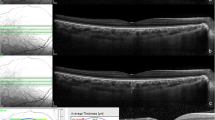Abstract
Background: GH exerts its effects on many organs and the eye also seems to be a target site, although few authors have investigated the corneal thickness in patients with acromegaly. Aim: To perform a detailed ophthalmological evaluation in acromegalic patients, in relation to disease activity. Material and methods: Twenty-eight acromegalic patients (11 males, 17 females) and 22 voluntary healthy subjects underwent complete metabolic and ophthalmological evaluation, including retinal thickness (RT), central corneal thickness (CCT), and intraocular pressure values (IOP). Results: Significantly greater CCT values were found in all acromegalic patients in comparison with controls (567 vs 528.5 μm; p<0.001), without concomitant greater corrected IOP. No difference was found for RT. Analyzing these data according to disease activity, uncontrolled patients showed greater CCT values (573.5 vs 559 μm; p=0.002) and corrected IOP (17.4 vs 16 mmHg; p=0.001) than the controlled ones. CCT also correlated with basal and nadir GH after oral glucose load levels, IGF-I levels, and duration of active disease. Conclusions: Acromegaly is characterized by greater CCT values, supporting the hypothesis that GH excess may have stimulatory effects on the cornea as well as on other target organs. Higher GH levels, disease control status and duration of active disease seem to be the main causes of increased corneal thickness. We suggest a careful and detailed corneal evaluation in acromegalic patients to prevent the potential risk of increased IOP, in addition to the already-known complications.
Similar content being viewed by others

References
Colao A, Marzullo P, Di Somma C. Lombardi G. Growth hormone and the heart. Clin Endocrinol (Oxf) 2001, 54: 137–54.
Sober AJ, Gorden P, Roth J, AvRuskin TW. Visceromegaly in acromegaly. Evidence that clinical hepatomegaly or splenomegaly (but not sialomegaly) are manifestations of a second disease. Arch Intern Med 1974, 134: 415–7
Gasperi M, Martino E, Manetti L, et al; Acromegaly Study Group of the Italian Society of Endocrinology. Prevalence of thyroid diseases in patients with acromegaly: results of an Italian multi-center study. J Endocrinol Invest 2002 Mar, 25: 240–5.
Harvey S, Baudet ML, Sanders EJ. Growth hormone and developmental ocular function: clinical and basic studies. Pediatr Endocrinol Rev 2007, 5: 510–5.
Van Setten G. Elevated intraocular levels of insulin-like growth factor I in a diabetic patient with acromegaly. Orbit 2002, 21: 161–7.
Harvey S, Kakebeeke M, Murphy AE, Sanders EJ. Growth hormone in the nervous system: autocrine or paracrine roles in retinal function? Can J Physiol Pharmacol 2003, 81: 371–84.
Harvey S, Baudet ML, Sanders EJ. Retinal growth hormone in perinatal and adult rats. J Mol Neurosci 2006, 28: 257–64.
Baudet ML, Hassanali Z, Sawicki G, List EO, Kopchick JJ, Harvey S. Growth hormone action in the developing neural retina: a proteomic analysis. Proteomics 2008, 8: 389–401.
Bourla DH, Laron Z, Snir M, Lilos P, Weinberger D, Axer-Siegel R. Insulinlike growth factor I affects ocular development: a study of untreated and treated patients with Laron syndrome. Ophthalmology 2006, 113: 1197.e1–5.
Bramsen T, Klauber A, Bjerre P. Central corneal thickness and intraocular tension in patients with acromegaly. Acta Ophthalmol (Copenh) 1980, 58: 971–4.
Greco AV, Ricci B, Altomonte L, Rebuzzi AG, Manna R, Ghirlanda G. GH secretion in open-angle glaucoma. Ophthalmologica 1979, 179: 168–72.
Giustina A, Barkan A, Casanueva FF, et al. Criteria for cure of acromegaly: a consensus statement. J Clin Endocrinol Metab 2000, 85: 526–9.
Matthews DR, Hosker JP, Rudenski AS, Naylor BA, Treacher DF, Turner RC. Homeostasis model assessment: insulin resistance and beta-cell function from fasting plasma glucose and insulin concentrations in man. Diabetologia 1985, 28: 412–9.
Baumal CR. Clinical applications of optical coherence tomography. Curr Opin Ophthalmol 1999, 10: 182–8.
Doughty MJ, Zaman ML. Human corneal thickness and its impact on intraocular pressure measures: a review and meta-analysis approach. Surv Ophthalmol 2000, 44: 367–408.
Ehlers N, Hansen FK. Central corneal thickness in low-tension glaucoma. Acta Ophthalmol (Copenh) 1974, 52: 740–6.
The Expert Committee on the Diagnosis and Classification of Diabetes Mellitus. Report of the Expert Committee on the Diagnosis and Classification of Diabetes Mellitus. Diabetes Care 1997, 20: 1183–97.
European Society of Hypertension-European Society of Cardiology Guidelines Committee. 2003 European Society of Hypertension-European Society of Cardiology guidelines for the management of arterial hypertension. J Hypertens 2003, 21: 1011–53.
National Cholesterol Education Program (NCEP) Expert Panel on Detection, Evaluation, and Treatment of High Blood Cholesterol in Adults (Adult Treatment Panel III). Third Report of the National Cholesterol Education Program (NCEP) Expert Panel on Detection, Evaluation, and Treatment of High Blood Cholesterol in Adults (Adult Treatment Panel III) final report. Circulation 2002, 106: 3143–4
Weinreb RN, Friedman DS, Fechtner RD, et al. Risk assessment in the management of patients with ocular hypertension. Am J Ophthalmol 2004, 138: 458–67.
Author information
Authors and Affiliations
Corresponding author
Rights and permissions
About this article
Cite this article
Ciresi, A., Amato, M.C., Morreale, D. et al. Corneainacromegalic patientsasapossible target of growth hormone action. J Endocrinol Invest 34, e30–e35 (2011). https://doi.org/10.1007/BF03347058
Accepted:
Published:
Issue Date:
DOI: https://doi.org/10.1007/BF03347058



